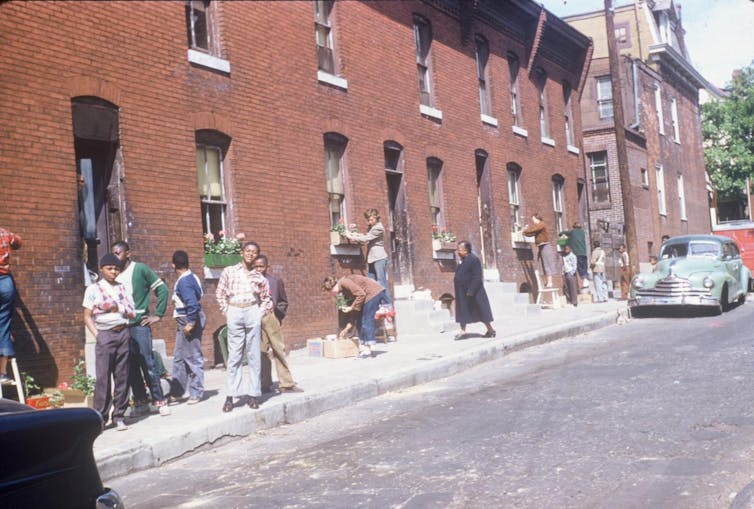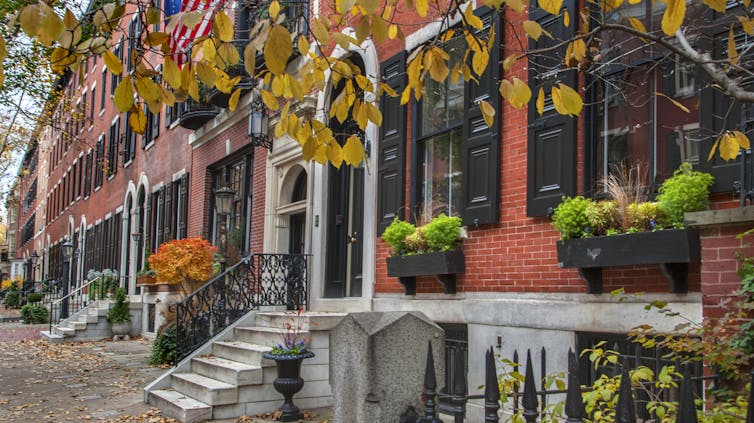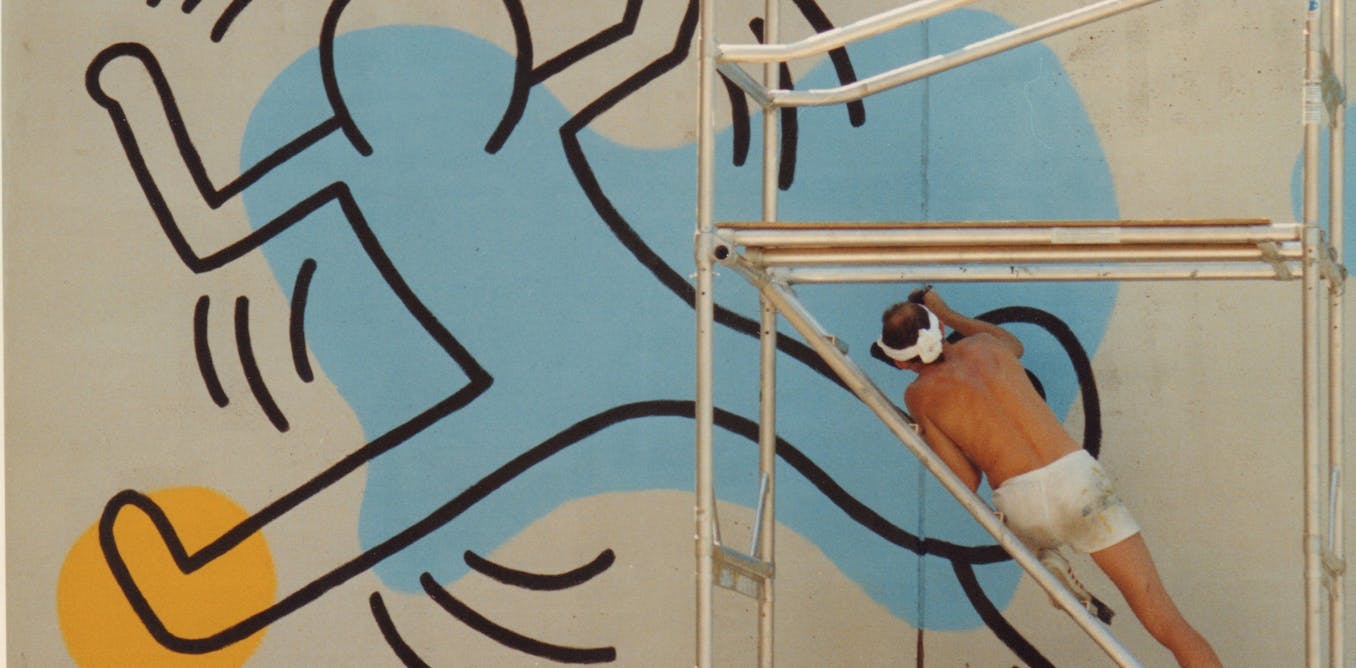It’s that time of year when Philadelphia row home owners with a green thumb fastidiously attend to their window boxes – selecting new plants to design an artful blend of colors, shapes and textures.
Sonja Dümpelmann is a historian of landscapes and the built environment who lived in Philly from 2019 to 2023. During this time, she researched how female reformers and activists in Philadelphia in the 19th and 20th centuries tended to window-box gardens both for charity and to spur urban renewal in rundown neighborhoods.
Dümpelmann recently published an article on this history in the architectural journal Buildings & Landscapes. She spoke with The Conversation U.S. about what she learned.
Sonja Dümpelmann, CC BY-SA
How did you become interested in window boxes?
When I first moved to Philadelphia from Cambridge, Massachusetts, in August 2019, I was immediately struck by the window boxes. The lushness and freshness of the plants in many of the boxes, and sometimes in sidewalk planters, made walking more pleasant and interesting. This was especially the case in the hot summer months when I would often see plants from subtropical and tropical climates in the Rittenhouse Square, Fitler Square and Graduate Hospital neighborhoods.
I noticed that there were three categories of window boxes. Many were visibly cared for, often freshly planted and decorated several times a year in accordance with the changing seasons. Some were derelict and had spontaneous growth of saplings and different grasses. And a third category were boxes outfitted with plastic plants, perhaps signaling absentee owners or landlords who seek to simulate care.
What makes them landscape architecture?
Window boxes – especially the planted boxes, but also painted boxes that are empty – change outdoor space and building exteriors. They make them more colorful and interesting, and they break up plain vertical walls by protruding from the facade.
You could say that the window boxes “greet” passersby. They connect private indoor space with the public realm of the street. As one early window-box promoter observed in 1903, “The man in the street gets as much enjoyment out of them as its owner.”
“Gardens in a box,” as they were also referred to by early promoters, can make homes and entire neighborhoods look and feel different. They forge distinct identities with their plant selection and the style and color of the boxes.

Sonja Dümpelmann, CC BY-SA
How did window gardening begin?
Window gardening became popular in Victorian England and continental Europe in the 19th century. It began as an indoor activity and was practiced especially by women, but it soon also moved outdoors. There it became part of what American women in the late 19th century called “municipal housekeeping.” It extended their conventional female roles as housekeepers and mothers into the larger “household” of the community.
Window gardening became a means of female social reform during the Progressive Era. During this period in the late 19th and early 20th centuries, when industries and cities were growing fast, women sought to improve education, public health and living conditions, especially for poor and immigrant communities. By offering plants, flowers and entire window boxes, the women supported homemakers of lesser means.
However, these boxes were also a way to make sure that order in and outside of homes was maintained. Window gardens became cultural symbols of cleanliness and good housekeeping. Furthermore, reformers considered window gardening as a practice that could help immigrants assimilate into American society.
When did they become political?
In Philadelphia there were two big window-gardening movements. The first occurred in the late 19th and early 20th centuries, and I describe it as window-box charity. The second, which I call window-box activism, began in the 1950s.
Window-box charity was carried out primarily by white philanthropists and social workers who would distribute plants and goods sent from outside the city to the urban poor and sick, especially immigrants and Black Americans. Sometimes the window boxes were ready to be installed outside the windows. Other times recipients built and planted boxes themselves.

Courtesy of the McLean Library and Archives, Pennsylvania Horticultural Society, Philadelphia, Pennsylvania
Several decades later, in the mid-20th-century, plants became a vehicle for white suburban garden club ladies and Black inner-city residents to counter urban decay resulting from racism and public disinvestment. On annual planting days, the garden club ladies brought plants into the city and joined residents in planting and installing window boxes to brighten up their neighborhood blocks.
Plants were key in both window-box charity and window-box activism. People came together to care for plants, creating friendships among neighbors and ties between low-income and wealthy neighborhoods. The women used plants and window boxes to protect private space and increase the safety of public space. In the 1960s, the Philadelphia police reported less crime on streets with window boxes.
Of course, window boxes and plants alone could not solve larger urban social problems such as poor housing conditions and racial discrimination. So while they could be catalysts of neighborhood change, they also helped to camouflage and quite literally naturalize larger social problems that required political responses.
Are they still linked to urban renewal?
Like a smaller version of public parks, community gardens and street trees, window gardens can contribute to green gentrification. This occurs when the construction of parks or the planting of trees contributes to an increase in property values that leads to the displacement of long-term residents in low-income neighborhoods.
Window gardening did help save some of Philly’s old row house neighborhoods from demolition during urban renewal beginning in the 1950s. However, quite a few of these neighborhoods – such as Washington Square West and Graduate Hospital – have since been gentrified, and families who once window gardened to turn their neighborhoods into more beautiful and safer places could no longer afford to live there.
The 20th century window-box activism drew the attention of sociologists and other national and international observers, especially because it brought white and Black residents together during the tensions of the Civil Rights Movement. It also raised public awareness about unequal access to urban green spaces.

Photo by R. Kennedy for Visit Philadelphia, CC BY-SA
Yet despite the movement’s good intentions and positive effects, racial segregation remains a persistent problem in Philadelphia.
In gentrified parts of Center City today, new and restored row houses often include fixtures and built-in irrigation pipes for window boxes. Many owners outsource window-box planting and maintenance to paid service providers.
But for lower-income residents, the costs in both time and money to install and maintain window gardens can be prohibitive.



